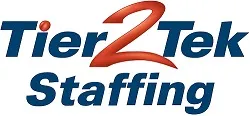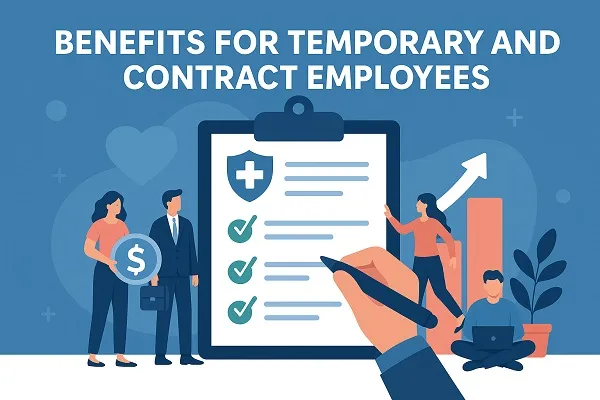Benefits for temporary and contract employees are an increasingly important consideration for HR leaders. Organizations depend on these workers for seasonal peaks, project-based assignments, and specialized expertise. Yet without benefits, temporary and contract employees may feel undervalued, leading to higher turnover and reduced productivity. By offering meaningful benefits and knowing where to source them, HR departments can strengthen recruitment, improve retention, and ensure compliance, all while supporting a healthier, more engaged workforce.
Why Benefits Matter for Contingent Staff
Temporary and contract employees are essential to organizational flexibility. They provide rapid support during busy seasons, bring specialized knowledge for projects, and fill critical staffing gaps. However, because they often lack the security of permanent roles, benefits become a crucial part of the employment package.
For HR teams, extending benefits leads to:
- Improved recruitment: Skilled professionals are more likely to accept contracts when benefits are included.
- Reduced turnover: Workers stay longer when they feel valued and supported.
- Stronger employer reputation: Companies known for fair treatment attract better talent.
- Compliance protection: Meeting benefit requirements reduces legal and regulatory risks.
Types of Benefits Temporary and Contract Employees Value Most
Health and Medical Benefits
Health coverage remains the most sought-after benefit for contingent staff. Even when full employer-paid insurance is not feasible, HR can provide access to affordable group plans, stipends, or telemedicine services.
Examples HR can implement:
- Group health plans through insurance carriers.
- Health stipends for employees to purchase their own coverage.
- Telehealth options that provide affordable access to doctors and specialists.
Paid Leave and Sick Time
Offering paid sick days or limited PTO ensures contingent workers can balance health and personal needs without financial stress. In states where paid sick leave is legally required, HR must ensure compliance for all staff, including short-term workers.
Retirement Savings Options
Some HR teams extend 401(k) or IRA participation to contract employees. Even voluntary, employee-funded options show commitment to long-term financial security. Retirement plans can often be integrated through payroll providers.
Wellness and Lifestyle Benefits
Wellness programs, mental health support, and lifestyle perks can make a meaningful impact at relatively low cost. These benefits contribute to overall well-being and foster loyalty among temporary staff.
Examples include:
- Employee Assistance Programs (EAPs).
- Wellness stipends for gyms or fitness apps.
- Discounts on transportation or commuting.
Professional Development Access
Although contingent workers may not stay long-term, offering access to training and development resources benefits both the employee and the organization. HR can provide access to e-learning libraries, certifications, or in-house training.
Where HR Can Source Benefits for Temporary and Contract Employees

The most critical part of benefits planning is knowing where HR can source cost-effective, compliant, and practical benefits for contingent staff. Unlike permanent employees, temporary and contract workers may not automatically fit into standard benefits packages. Below are detailed strategies HR teams can use to source and structure benefits effectively.
1. Partnering With Staffing Agencies
Many organizations hire temporary employees through staffing agencies. In these cases, the agency typically manages payroll and benefits. HR can leverage this by negotiating benefit standards directly with agencies.
Advantages for HR:
- Reduces administrative burden for the organization.
- Provides workers with consistent access to health insurance, retirement plans, or PTO.
- Allows HR to align agency-provided benefits with company values and compliance requirements.
Best practice: Choose agencies that offer competitive benefits packages and communicate those clearly during recruitment.
2. Working With Third-Party Benefits Providers
A growing number of vendors specialize in offering portable benefits for gig workers, freelancers, and contract employees. HR can contract with these providers to extend affordable benefit options to contingent staff.
Types of third-party providers:
- Portable benefits platforms: Companies like Trupo, Stride Health, or Catch offer health, dental, vision, and retirement products tailored for nontraditional workers.
- Freelance benefit networks: Membership-based organizations provide discounted access to insurance, retirement plans, and wellness programs.
- Industry associations: Trade associations often provide group insurance or retirement benefits for members.
HR benefit: These solutions give workers access to benefits they can carry from one contract to the next, reducing turnover and boosting satisfaction.
3. Leveraging Payroll and HR Technology
Modern payroll and HRIS (Human Resource Information Systems) platforms increasingly allow HR teams to extend voluntary benefits to non-permanent staff.
Examples of available options:
- ADP, Paychex, and TriNet: Offer benefits administration that can cover contractors.
- PEOs (Professional Employer Organizations): Pool employees across multiple companies, lowering the cost of health insurance and retirement plans.
- Voluntary benefits add-ons: Dental, vision, life, and disability coverage offered on an opt-in basis.
HR benefit: These systems centralize payroll and benefits, streamlining administration and compliance.
4. Government and Marketplace Resources
In some cases, HR may not directly provide benefits but can guide workers toward government-supported or marketplace programs. Acting as a resource helps build trust and ensures compliance with state and federal laws.
Examples HR can promote:
- ACA marketplace plans for affordable health insurance.
- State-run retirement programs, such as CalSavers in California or OregonSaves.
- Public leave programs, where applicable, for family and medical leave.
HR benefit: Even if the company cannot afford to directly fund benefits, providing education and resources ensures employees have access to support.
5. Creating Tiered or Flexible Benefit Packages
Some organizations design flexible benefits packages specifically for contingent staff. These allow HR to scale benefits depending on contract length, hours worked, or project type.
Approaches HR can use:
- Tiered benefits (e.g., health stipends for contracts over three months, PTO eligibility after six months).
- Cafeteria-style plans where employees choose from a menu of perks.
- Shared-cost models where the employer subsidizes a portion of premiums.
HR benefit: Flexibility allows companies to control costs while still offering meaningful support to workers.
6. Collaborating With Insurance Brokers
Insurance brokers can design tailored benefits packages that include temporary and contract staff. By leveraging group purchasing power, brokers often negotiate better rates than companies can access on their own.
What HR gains:
- Access to customizable health, dental, and vision plans.
- Options for short-term disability or accident insurance.
- Expertise in navigating compliance requirements.
This partnership ensures HR teams can offer professional, compliant benefits without taking on administrative complexity.
7. Leveraging Employee Discount and Perk Platforms
Even if traditional insurance coverage isn’t feasible, HR can still provide valuable perks through employee discount platforms.
Options include:
- Corporate discount programs for travel, shopping, or entertainment.
- Online wellness subscriptions (fitness apps, meditation tools).
- Education discounts for courses or certifications.
HR benefit: These low-cost programs boost morale and make workers feel included in company culture.
The Organizational Impact of Offering Benefits
When HR sources and provides benefits for temporary and contract employees, the payoff goes beyond individual satisfaction. Employers see stronger recruitment, reduced turnover, and higher productivity. Workers are more engaged, healthier, and motivated to contribute at a high level.
For HR leaders, the path forward lies in building partnerships with staffing agencies, benefit providers, payroll platforms, and government programs. By combining these resources, HR can deliver a competitive, sustainable benefits strategy that supports every member of the workforce.
Content reviewed and published by Tier2Tek Staffing Editorial Team .

